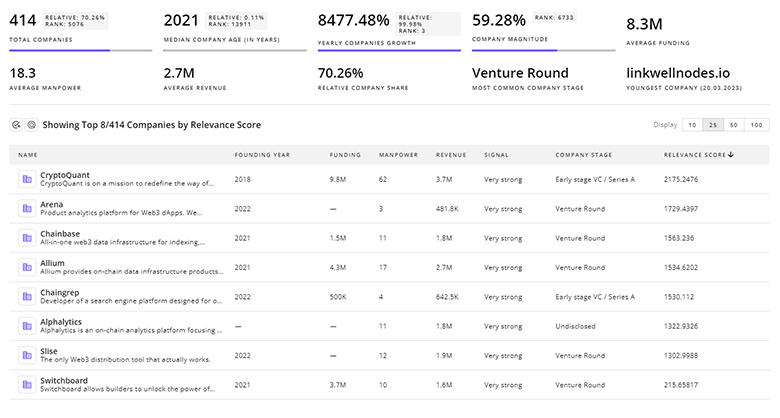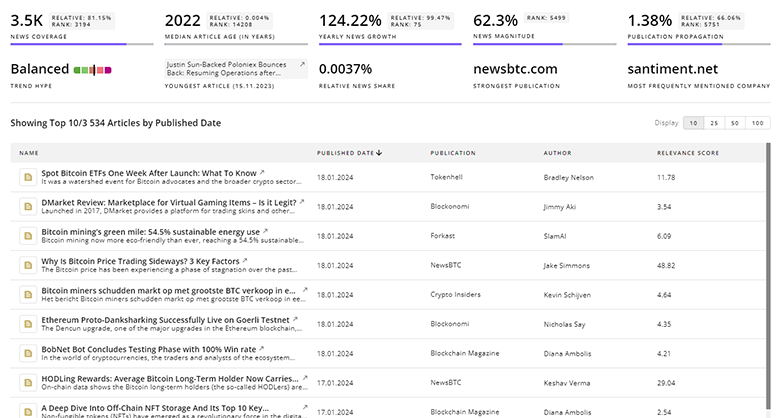
Automation Report
: Analysis on the Market, Trends, and TechnologiesThe automation landscape is at an inflection point: patent and industry data show large-scale innovation (123,941 patents recorded for “automation” topics) while market forecasts indicate multi-billion-dollar expansion in adjacent segments, signalling strategic urgency for enterprise adopters and investors. This report synthesizes patent, market, company, and news signals to show that AI-driven hyperautomation, agentic workflows, and edge-enabled industrial control will drive near-term deployment choices and vendor consolidation, while low-code/no-code and privacy-first architectures open adoption pathways for mid-market firms.
This report was last updated 26 days ago. Spot an error or missing detail? Help us fix it by getting in touch!
Topic Dominance Index of Automation
To identify the Dominance Index of Automation in the Trend and Technology ecosystem, we look at 3 different time series: the timeline of published articles, founded companies, and global search.
Key Activities and Applications
- Intelligent process discovery and end-to-end orchestration: automated task and process discovery feeds candidate lists into orchestration layers that chain RPA, ML models, and decision rules to automate complex business flows.
So what? Process discovery reduces wasted automation effort and raises ROI by prioritizing high-impact workflows for orchestration. - Agentic automation and digital workers: AI agents plan, act, and manage multi-step processes in domains with exceptions (claims, onboarding, legal intake), moving beyond scripted bots toward autonomous decision-centric execution.
So what? Organizations can reassign human labor from repetitive coordination to exception handling and governance, accelerating throughput without proportional headcount growth. - Intelligent Document Processing and IDP at scale: NLP/OCR combined with ML handles unstructured inputs (invoices, contracts) to feed downstream automations and compliance reporting.
So what? Faster finance close cycles and lower claims-processing cost; IDP becomes the gating factor for many back-office automations. - Edge and industrial control automation: IIoT + edge compute + digital twins enable real-time control, predictive maintenance, and localized autonomy in factories and utilities.
So what? Firms in manufacturing and energy lower downtime and energy use; decisions shift from periodic batch analysis to continuous control loops. - Quality inspection and vision-AI in production: computer vision replaces manual QA for defect detection, improving yield and reducing scrap.
So what? Reduces cost per unit and supports sustainability targets through waste reduction. - Customer-facing automation (bots and voice agents): conversational AI and 24/7 voice agents handle high-volume interactions, freeing human agents for escalations automateplanet.com.
So what? Improves response SLAs and drives measurable reductions in support cost per ticket. - Autonomous transport and mobility control: rail and fleet automation apply agentic control, sensor fusion, and safety-certified stacks for capacity and safety gains.
So what? Long procurement cycles but high strategic value for infrastructure owners through capacity and safety improvements.
Emergent Trends and Core Insights
- Agentic workflows move from research to production: enterprise roadmaps prioritize specialized AI agents that execute multi-step workflows with audit trails; buyers demand orchestration, governance, and auditability.
So what? Vendors that pair agentic capability with governance modules capture enterprise accounts faster. - Hyperautomation growth intensifies platform convergence: the market favors integrated platforms that combine process mining, RPA, IDP, LLMs, and orchestration rather than point tools Next Generation Business Automation Platforms.
So what? Buyers will consolidate stacks; niche vendors must expose composable APIs and partner strongly with platform leaders. - Real-time, edge-centric industrial automation rises: 5G, edge compute, and IIoT enable sub-second control loops for manufacturing and logistics, shifting value to edge software and secure device management Imaginovation.
So what? Companies that provide secure edge orchestration and digital twin integration gain traction in brownfield upgrades. - Low-code/no-code democratization persists: citizen developers expand automation coverage, but centralized governance and observability become mandatory to prevent sprawl FlowForma.
So what? IT must adopt guardrails and business value KPIs to scale safely. - Sustainable automation and ESG reporting embedded in workflows: automation becomes a data source for ESG metrics, with platforms ingesting sensor and process data for reporting.
So what? Automation projects that produce measurable emissions or waste improvements win executive sponsorship. - Privacy-first and self-hosted AI adoption grows: regulated sectors prefer on-prem/private deployments of AI agents to control data exposure and satisfy compliance Hostinger trends.
So what? Vendors must offer hybrid architectures and private-inference options to access regulated verticals. - Process mining + business observability become procurement criteria: buyers demand evidence of value (process KPIs) before large automation bets.
So what? Sellers that embed process-to-value dashboards shorten procurement cycles.
Quote: "Agentic workflows promise to transform knowledge work, but organizations must focus on high-value applications" — a concise buyer imperative from recent IDC analysis Moving Agentic Workflows into Work.
Technologies and Methodologies
- Large language models and LLM orchestration: LLMs power natural-language process design, conversational agents, and parts of IDP, but enterprises expect governance and hallucination controls Automation Anywhere Features Responsible AI.
So what? Responsible-AI layers and certifiable traceability become minimally required platform features. - RPA with AI extensions (cognitive RPA): RPA remains foundational but now must integrate ML for decisioning, IDP, and process discovery.
So what? Pure script-based vendors must add ML/IDP to stay relevant. - Process mining and task mining: automated discovery identifies automation candidates and measures pre/post impact, enabling value-driven roadmaps.
So what? Mining reduces pilot failure rates and informs prioritization. - Edge computing and IIoT stacks: secure device management, digital twins, and real-time analytics support machine and plant control use cases.
So what? OT/IT convergence projects require cybersecurity and lifecycle management capabilities. - Low-code/no-code platforms and visual orchestration: enable business builders to deliver automations under governance; critical for scale Decisions Automateo.
So what? Firms should pair citizen dev access with formal change control and monitoring. - Digital twin and simulation for virtual commissioning: use in manufacturing to validate flows and train agentic policies before live runs.
So what? Lowers commissioning risk and enables faster ramp to lights-out production. - AI orchestration and agent management platforms: manage lifecycle, credentials, observability, and audit trails for deployed agents IDC forecast.
So what? Operational maturity requires agent orchestration to be part of automation center-of-excellence tooling.
Automation Funding
A total of 20.2K Automation companies have received funding.
Overall, Automation companies have raised $639.5B.
Companies within the Automation domain have secured capital from 68.4K funding rounds.
The chart shows the funding trendline of Automation companies over the last 5 years
Automation Companies
- Automata Intelligence — A London-based AI automation agency that runs 300+ automations monthly and reports 105,000–120,000 jobs processed, saving roughly 6,500 human hours per month; the firm focuses on bridging data silos and delivering generative AI integrations for operational workflows, making it a practical partner for mid-market adopters needing rapid time-to-value.
- ETM Automation Pvt Ltd — India-based manufacturing automation specialist that integrates AI, smart sensors, and digital-thread approaches to create SMART Factories; ETM emphasizes reuse of engineering knowledge and digital-thread implementations to accelerate plant modernization and predictive maintenance programs.
- Verbotics — Small Australian vendor that automates offline robot programming (Verbotics Weld) to remove programming bottlenecks in welding cells; their approach reduces skill requirements and shortens robot deployment time for low-volume manufacturers, lowering automation TCO for SMEs.
- Maisa — San Francisco-based provider of agentic process automation that targets decision-heavy, exception-rich enterprise processes; Maisa emphasizes auditable, programmatic execution so digital workers make traceable choices in regulated workflows such as finance and legal intake.
- lowtouch.ai — Boston-based vendor offering no-code, private AI agents that run within enterprise infrastructure to meet data privacy and compliance needs; the platform targets help-desk automation, SRE workflows, and secure agent deployment models favored by regulated buyers.
(Each company above maps directly to activities listed earlier: process discovery, agentic automation, edge/industrial integration, IDP/vision QA, and privacy-first agent deployments.)
Identify and analyze 254.6K innovators and key players in Automation more easily with this feature.

254.6K Automation Companies
Discover Automation Companies, their Funding, Manpower, Revenues, Stages, and much more
Automation Investors
TrendFeedr’s investors tool offers a detailed view of investment activities that align with specific trends and technologies. This tool features comprehensive data on 43.6K Automation investors, funding rounds, and investment trends, providing an overview of market dynamics.

43.6K Automation Investors
Discover Automation Investors, Funding Rounds, Invested Amounts, and Funding Growth
Automation News
Stay informed and ahead of the curve with TrendFeedr’s News feature, which provides access to 175.0K Automation articles. The tool is tailored for professionals seeking to understand the historical trajectory and current momentum of changing market trends.

175.0K Automation News Articles
Discover Latest Automation Articles, News Magnitude, Publication Propagation, Yearly Growth, and Strongest Publications
Executive Summary
Automation now requires two simultaneous capabilities: intelligent decisioning (agents, AI/ML, IDP) and disciplined operational controls (process mining, governance, observability). Market signals show strong software growth while industrial hardware markets expand at steadier rates; buyers must therefore choose platforms that combine agentic capabilities with enterprise governance and hybrid deployment options. For product leaders and investors, the winning profiles are platforms that package agent orchestration, measurable process ROI, and enterprise deployment choices (cloud/private/edge). For enterprise technology buyers, prioritizing high-value processes with clear KPIs, pairing citizen developer access with strict observability, and insisting on privacy-first options will convert pilots into sustained efficiency gains and measurable business outcomes.
Interested in enhancing our coverage of trends and tech? We value insights from experts like you - reach out!










